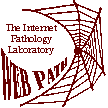Why was a chromosome analysis performed in this case?
There is advanced maternal age. The risk for Down syndrome goes up with age: 1:1500 at age 20, 1:100 at age 40, 1:25 at age 45.
What would a karyotype of the parents show in this case?
The karyotype is probably normal.
However, the translocation type of Down syndrome accounts for about 4% of cases. It is familial, because one of the patients is a carrier of the so-called "Robertsonian" translocation (which is a balanced translocation so the carrier is normal). There is a 50% chance that the fetus will be non-viable if one parent has this translocation, while a third of viable fetuses will have Down syndrome.

Down syndrome accounts for about a third of school-age children with moderate to severe mental retardation. They are happy, docile children.
What are long term complications of this disorder?
In the neonatal period, 10% of cases may be complicated by Hirschsprung's disease. Persons with Down syndrome may develop leukemia in early adulthood. Those who live longer often develop Alzheimer's disease.
The most frequently discussed chromosomal abnormalities:
Trisomy 13: Features include microcephaly, cleft lip and/or palate,
polydactyly, cardiac defects.
Trisomy 16: Seen in abortuses from first trimester. Never liveborn.
Trisomy 18: Features include micrognathia, overlapping fingers, horseshoe kidney, rocker bottom feet, cardiac defects.
Trisomy 21: Down syndrome; incidence based upon maternal age, though
translocation type is familial; features include epicanthal folds, transverse
crease, brachycephaly, cardiac defects.
Monosomy X: Turner's syndrome; can survive to adulthood; features
include short stature, cystic hygroma of neck (leading to webbing), infertility, coarctation.
XXY: Kleinfelter's syndrome; features include elongated lower body,
gynecomastia, testicular atrophy.

What would you advise the parents when prenatal testing reveals the baby's karyotype is 21, XX, +21?
In some ways dealing with trisomy 21 is a more difficult decision for parents than dealing with more serious chromosomal abnormalities, when it is discovered in the first trimester by the “triple screen” test that is commonly available. You will need to explain the best you can what it is like to have a child with Down syndrome in an unbiased way, and that's not easy. Persons with Down syndrome can have a wide range of problems from mild to severe mental disability and from manageable physical defects to congenital cardiac defects requiring multiple open heart surgeries. The parents can wait until the baby is born, but then the choices become much more difficult. If they choose to terminate the pregnancy, they should not be condemned in any way. As a caregiver you have to choose every word you use very carefully.
You may or may not want to advise carrying the pregnancy to term; you may or may not support abortion as an alternative. However, you need to provide information regarding outcomes. You can tell parents some things they may not know, like these children are typically very sweet and loving, and many of them are capable of more than we realize. You can tell them that there are both short-term and long-term medical problems. You can ask them if they would like to meet parents of children with Down syndrome. No matter what you tell them, you have to appreciate that adapting to a child with Down syndrome is not an easy thing for parents, and it will impact the lives of any siblings as well (and though the siblings will lose some things from this addition to the family, they will also gain something special, too, in the long run).
What you will find is that many parents already have an idea of what they would do in this situation. Some may have such strong anti-abortion views, for example, or friends with a Down syndrome baby, that they feel like they knew the risks already and are prepared to accept this child into their family. Or they may feel they are not up to the task, and be sufficiently pro-choice, that they will make the decision pretty quickly. But caution: this is not a political decision. Being anti-abortion or pro-choice will not make this an easy decision emotionally—the parents will have many questions and doubts about whether they did the right thing no matter what they choose to do.



